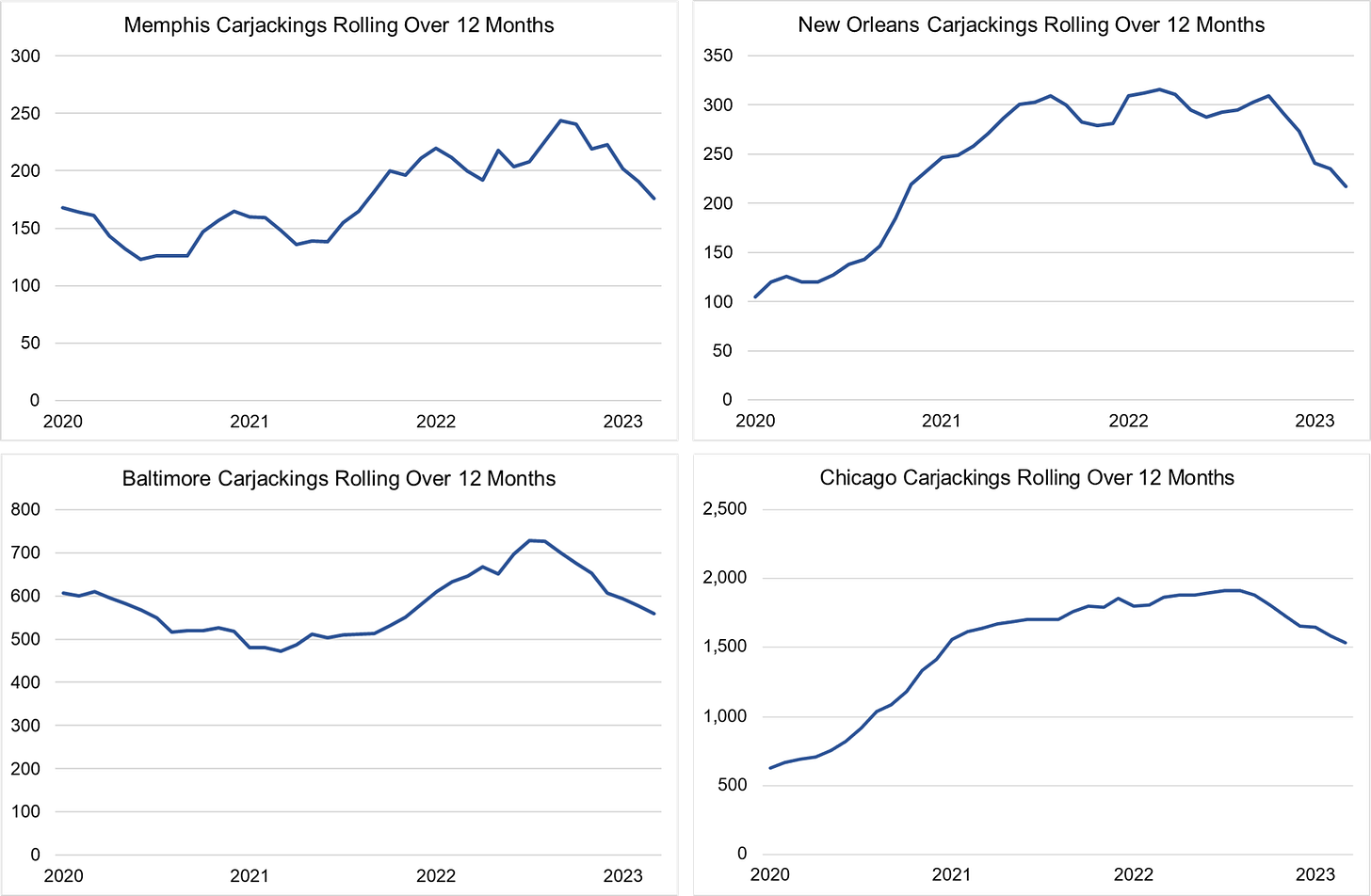Are Carjackings Falling Because Cars Are Easier to Steal?
Available data points to a clear answer: Maybe!
Auto thefts are rising and they might be accompanied by an unexpected trend: falling carjackings. The logic seems straightforward, carjackings — a robbery where the victim's car is taken — are relatively rare, and why steal a car at gunpoint if you can easily steal a certain type of car from the street when nobody is around?
Stealing cars is easier than carrying out a carjacking and there is less risk of getting caught. The clearance rate for robberies in 2019 was 30.5 percent compared to 13.8 percent for auto thefts according to the FBI. Chicago posts data on whether an incident led to an arrest which shows a similar trend — albeit at a way lower rate — with less than 2 percent of auto theft incidents and 4.5 percent of carjackings having an arrest this year.
It would stand to reason, therefore, that carjackings might fall in a world of surging auto thefts. Sadly, data collection and reporting might not be sufficient to say more confidently whether this is a real trend or if I’m trying to read a signal in a lot of noise. The available data looks intriguing, but as Daniel Kahneman says in his book Thinking Fast and Slow: “The tendency to see patterns in randomness is overwhelming.”
Crime trends are usually complicated with many possible contributing factors and explanations. The national surge in auto thefts that followed the video posted on TikTok in July was the rare trend that was both simple and obvious in the data. As a reminder of what that trend looks like, here are auto thefts per month in Chicago since 2020 (can YOU spot when the TikTok video launched?).
The FBI includes auto thefts as one of its major types of crime and thousands of agencies report those figures every year. Measuring carjackings is nowhere near that simple. Part of the challenge with answering whether more auto thefts is causing fewer carjackings is that carjackings like shootings, is not a category of crime that is formally tracked by the FBI. Carjackings are usually lumped in along with other, more common, forms of robbery in most cities.
A few cities do publish data on carjackings in either their crime incidents or Calls for Service data. I found data from 14 such cities though New York City’s data is not yet updated through the first quarter of 2023 so I’m relying on Q4 2022 data for NYC. Carjackings are falling and auto thefts are rising in 9 of the 14 cities that had YTD data (including Q4 2022 vs Q4 2021 in NYC). Both carjackings and auto thefts are rising in 1 agency, both crime types are falling in 2 cities, and carjackings are rising while auto thefts are falling in 2 cities.
Of course YTD data is not always a great barometer of crime trends, especially this early in the year. A simple way to think about the potential impact of auto thefts on carjackings can be seen in the below graph. Each month is color coded to the percent change relative to the same month the previous year in the 9 cities with rising auto thefts and falling carjackings. The redder rectangles mean carjackings were up relative to the same month in the previous year and vice versa with the greener rectangles. There is a lot of red prior to July 2022 and a lot of green after it though it doesn’t exactly look like the switch being turned on and suddenly fewer carjackings like with the auto theft trend.
Yet another way to evaluate the role of auto thefts in carjackings is rolling over 12 months. Below are graphs of carjackings rolling over 12 months in 4 cities with reasonably large increases in auto thefts and reasonably large drops in carjackings. Carjackings were either rising (Memphis, Chicago and Baltimore) or at an elevated level (New Orleans) before clearly falling beginning in Q3/Q4 2022. Carjackings peaked between August and October in all four cities suggesting there might be a connection between the carjacking and auto theft trends.
None of this is conclusive proof that more auto thefts are leading to fewer carjackings.
To begin with, the sample of cities with data on carjackings is very small and not every city is seeing the same trend. There are places like Washington, DC, Montgomery County, MD, and Milwaukee where the trend is heading the other direction. There are other places like Denver where carjackings began falling earlier in the year (April/May). Additionally, carjackings are rare events relative to robberies and auto thefts, so a small random change could have an outsized impact on what looks like a trend. Finally, the connection between falling carjackings and the TikTok video being posted does not seem to line up temporally quite as well as the rise in auto thefts does suggesting any potential relationship may not be especially strong and universally felt.
It could be that people are doing fewer carjackings because cars are much easier to flat out steal now, but it could also be a series of random datapoints that look like a pattern that would make sense if true. As Kahneman puts it later in his book, “Our predilection for causal thinking exposes us to serious mistakes in evaluating the randomness of truly random events.”
Pretty much every one of my posts analyzing national crime trends ends with a plea for more data to more confidently answer a question, but this is especially true with respect to carjackings. It is not an official category of crime data and the number of agencies that publish data on it is low. It’s a really interesting possibility, but not quite proven at this point.







More Please!
We need a subcategory called existential carjacking - for no purpose whatsoever.